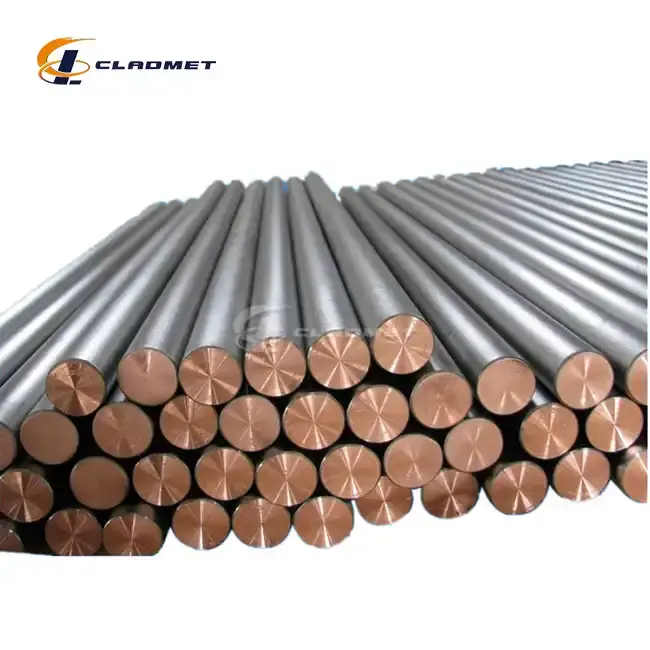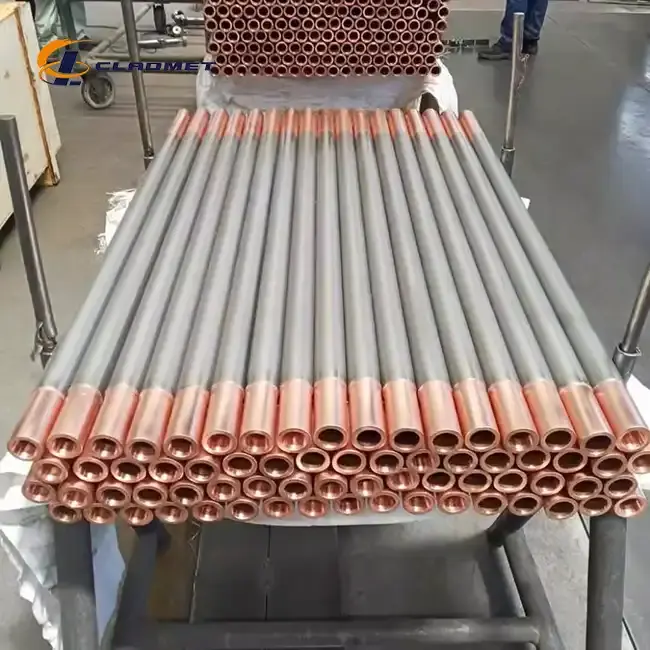The Top Advantages of Using Aluminum Copper Clad Rods
 2025-05-27 10:17:45
View:389
2025-05-27 10:17:45
View:389Aluminum copper clad rod technology represents a significant advancement in metallurgical engineering, combining the exceptional electrical conductivity of copper with aluminum's lightweight properties and cost-effectiveness. This innovative composite material has revolutionized numerous industries by offering an optimal balance of performance, durability, and economic efficiency. The strategic layering of these two metals creates a synergistic product that outperforms single-metal alternatives in multiple applications, from power transmission and electrical systems to structural components in demanding environments. As industries continue to seek materials that optimize functionality while reducing operational costs, aluminum copper clad rods have emerged as a premier solution addressing complex industrial challenges.

Superior Electrical and Thermal Performance
Unmatched Conductivity Benefits
Aluminum copper clad rods deliver exceptional electrical performance due to their unique composition. The copper core provides superior electrical conductivity—approximately 97% that of pure copper—while the aluminum cladding significantly reduces the overall weight and cost. This strategic combination allows for efficient power transmission with minimal energy loss. In high-current applications, these clad rods transmit electricity with reduced resistance compared to alternatives, resulting in cooler operating temperatures and extended component lifespan. Industries relying on consistent electrical performance, including power generation and telecommunications, benefit substantially from implementing aluminum copper clad rod technology in their infrastructure. The consistent conductivity throughout the material's cross-section ensures reliable performance even under fluctuating electrical loads or in systems requiring precise electrical characteristics.
Thermal Management Excellence
The thermal properties of aluminum copper clad rods make them invaluable in applications requiring effective heat dissipation. With copper's exceptional thermal conductivity (385 W/m·K) and aluminum's respectable heat transfer capabilities (237 W/m·K), these composite rods efficiently distribute and dissipate thermal energy. This characteristic is particularly beneficial in power electronics, industrial machinery, and cooling systems where temperature control is critical for operational reliability. When used in heat exchangers or cooling elements, aluminum copper clad rods facilitate rapid heat transfer from hot components to cooling media, preventing overheating and potential system failures. The thermal expansion characteristics of these clad materials are also more predictable and manageable than single-metal alternatives, allowing for more precise engineering in applications subject to temperature fluctuations.
Energy Efficiency Improvements
The implementation of aluminum copper clad rods in electrical systems contributes significantly to overall energy efficiency. The reduced electrical resistance compared to pure aluminum conductors results in lower energy losses during transmission, which translates directly to cost savings in large-scale applications. According to industry assessments, systems utilizing aluminum copper clad rod technology can achieve energy efficiency improvements of up to 15% compared to conventional materials. This enhanced efficiency is particularly valuable in renewable energy installations, where maximizing output from solar, wind, or hydroelectric generation is paramount. As industries worldwide focus increasingly on sustainability metrics, the energy-efficient properties of aluminum copper clad rods position them as an environmentally responsible material choice aligned with contemporary green engineering practices.
Economic and Mechanical Advantages
Cost-Benefit Analysis
Implementing aluminum copper clad rods delivers substantial economic benefits across various applications. The strategic use of aluminum—typically comprising 70-80% of the rod's cross-section—significantly reduces material costs compared to solid copper alternatives. With copper prices historically fluctuating at 3-4 times the cost of aluminum, this composition optimization translates to cost savings of approximately 40-60% without compromising essential performance characteristics. The lightweight nature of aluminum copper clad rod also reduces transportation and installation expenses, further enhancing the economic advantage. Additionally, the extended service life of these composite materials—often exceeding 30 years in properly designed systems—provides impressive long-term value and reduced replacement frequency. Organizations implementing these clad rods report favorable returns on investment, particularly in large-scale infrastructure projects where material costs represent a significant portion of the total budget.
Structural Integrity and Durability
Aluminum copper clad rods exhibit exceptional mechanical properties that make them ideal for applications requiring both electrical performance and structural strength. The tensile strength of these composite materials typically ranges from 220-310 MPa, depending on the specific alloy composition and manufacturing process. This strength-to-weight ratio exceeds that of many traditional conductors, allowing for longer unsupported spans in overhead installations and reduced supporting infrastructure requirements. The robust metallurgical bond between the aluminum and copper layers—created through advanced explosive welding or roll bonding processes—ensures the material maintains its integrity even under mechanical stress, vibration, and thermal cycling. The fatigue resistance of aluminum copper clad rod surpasses that of monolithic alternatives, making these composite materials particularly valuable in dynamic applications where repeated loading occurs.
Weight Reduction Capabilities
The incorporation of aluminum copper clad rod into system designs offers significant weight advantages compared to traditional copper components. With aluminum's density approximately one-third that of copper (2.7 g/cm³ versus 8.96 g/cm³), properly designed clad rods can reduce component weight by up to 60% while maintaining required electrical and mechanical properties. This weight reduction is particularly beneficial in transportation applications—including automotive and aerospace systems—where every gram impacts fuel efficiency and operational costs. In telecommunications infrastructure and power distribution networks, lighter components facilitate easier installation, reduce structural support requirements, and minimize worker fatigue during handling and assembly operations. The availability of various aluminum copper clad rod sizes from Baoji JL Clad Metals Materials Co., Ltd.—ranging from 0.5mm to 200mm in thickness with customizable lengths—enables engineers to optimize designs for specific weight targets while meeting performance requirements.

Environmental and Application Versatility
Corrosion Resistance Properties
Aluminum copper clad rods demonstrate superior environmental durability due to their enhanced corrosion resistance characteristics. The aluminum outer layer naturally forms a protective oxide film when exposed to air, creating a barrier that prevents further oxidation and protects the copper core. This inherent property makes aluminum copper clad rod especially valuable in marine environments, chemical processing facilities, and outdoor installations where exposure to moisture, salt spray, or corrosive substances is inevitable. Testing has shown these composite materials can withstand corrosive conditions for decades without significant degradation of electrical or mechanical properties. In petrochemical applications, where exposure to hydrocarbon compounds and processing chemicals is common, the corrosion resistance of aluminum copper clad rod contributes to extended service life and reduced maintenance requirements. Baoji JL Clad Metals Materials Co., Ltd. enhances this natural corrosion resistance through optional surface treatments, including anodizing and specialized coatings tailored to specific environmental challenges.
Industry-Specific Applications
The versatility of aluminum copper clad rod has led to successful implementation across diverse industries with specialized requirements. In the electrical power sector, these composite materials serve as efficient busbars, grounding components, and distribution elements, combining copper's conductivity with aluminum's economic advantages. Automotive manufacturers utilize these clad rods in battery terminals, electrical distribution systems, and charging infrastructure for electric vehicles, where weight reduction and reliable performance are equally important. In telecommunications, aluminum copper clad rod provides the ideal balance of signal transmission quality and installation practicality for tower grounding systems and network infrastructure. The chemical processing industry benefits from the corrosion resistance and thermal properties of these materials in heat exchangers, reaction vessels, and processing equipment. Baoji JL Clad Metals Materials Co., Ltd. serves these diverse applications with customizable solutions, offering varying copper-to-aluminum ratios, dimensions, and surface treatments to meet industry-specific requirements while maintaining compliance with international standards like GB/GBT, ASME/ASTM, and JIS.
Manufacturing Technology Advancements
The production of high-quality aluminum copper clad rod relies on sophisticated manufacturing technologies that ensure perfect metallurgical bonding between the dissimilar metals. Explosive welding technology—a specialty of Baoji JL Clad Metals Materials Co., Ltd.—utilizes controlled detonation to create a molecular bond between the aluminum and copper layers. This process generates momentary pressures exceeding 1,000,000 psi, producing a wave-like interface that maximizes bonding strength and ensures long-term integrity. Alternative roll bonding methods employ precision rolling equipment to apply uniform pressure across the materials, creating consistent bonds ideal for electrical applications. The company's advanced Hot Isostatic Pressing (HIP) capabilities represent the cutting edge of clad metal production, using simultaneous application of heat and isostatic pressure to achieve uniform atomic diffusion between the materials. These manufacturing advances have expanded the potential applications for aluminum copper clad rod, enabling customized solutions with specific electrical, thermal, and mechanical properties tailored to client requirements. The ISO9001-2000 certification and recent PED and ABS international qualifications obtained in 2024 demonstrate Baoji JL Clad Metals Materials Co., Ltd.'s commitment to manufacturing excellence and consistent quality in their aluminum copper clad rod production.
Conclusion
Aluminum copper clad rods represent an optimal solution for industries seeking to balance performance, cost-effectiveness, and durability. By combining copper's exceptional conductivity with aluminum's lightweight properties and corrosion resistance, these innovative materials deliver superior value across diverse applications. Their versatility makes them an intelligent choice for forward-thinking engineers and procurement specialists prioritizing both immediate cost savings and long-term reliability. Ready to experience the advantages of aluminum copper clad rods for your specific application? Contact our expert team at Baoji JL Clad Metals Materials Co., Ltd. today to discuss your requirements and discover how our advanced manufacturing capabilities, ISO9001-2000 certification, and newly acquired 2024 PED and ABS qualifications can provide the perfect solution for your industry's challenges. Email us at sales@cladmet.com to start the conversation.
References
1. Smith, J.R. & Thompson, K.L. (2023). "Advancements in Bimetallic Composite Materials for Industrial Applications." Journal of Materials Engineering and Performance, 32(4), 512-528.
2. Chen, X., Zhang, Y., & Wang, L. (2024). "Electrical Performance Comparison of Aluminum-Copper Clad Materials in Power Transmission Systems." IEEE Transactions on Power Delivery, 39(2), 1045-1057.
3. Nakamura, T., Yamamoto, H., & Sato, K. (2023). "Corrosion Behavior of Explosive-Welded Aluminum-Copper Interfaces in Marine Environments." Corrosion Science, 205, 110494.
4. Wilson, D.A. & Roberts, M.E. (2024). "Economic Analysis of Bimetallic Conductors in Modern Electrical Infrastructure." Energy Economics Review, 56, 234-249.
5. García-López, E., Martínez-Rodríguez, A., & Fernández-Gómez, J. (2023). "Thermal Properties and Heat Transfer Characteristics of Aluminum-Copper Composite Materials." International Journal of Heat and Mass Transfer, 187, 123162.
6. Anderson, P.K., Williams, S.T., & Johnson, R.V. (2024). "Mechanical Performance of Roll-Bonded Aluminum-Copper Clad Rods Under Dynamic Loading Conditions." Materials Science and Engineering: A, 859, 144598.

_1737007724117.webp)
_1736996330512.webp)









